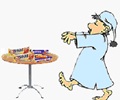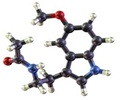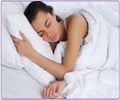Snoring is a symptom of obstructive sleep apnea, a sleep disorder that causes people to temporarily stop breathing many times a night and appears to
Snoring is a symptom of obstructive sleep apnea, a sleep disorder that causes people to temporarily stop breathing many times a night and appears to also promote bed-wetting in children, said Dr. Lee J. Brooks, a clinical associate professor of pediatrics at the University of Pennsylvania in Philadelphia.
In a study of 160 kids ages 4 to 17 who were referred to a sleep-disorders clinic for suspected breathing problems at night, 66 children (41 percent) were also bed-wetters.
Previous sleep research has indicated that one breathing disturbance per hour is the "upper limit of normal" in children, the study authors note in their report, published in a recent issue of The Journal of Pediatrics.
The findings show that "children with sleep apnea are at greater risk for nocturnal enuresis (bed-wetting) than children without sleep apnea," Brooks said.
About 10 percent of kids snore, he said, and 10 percent of those who snore have sleep apnea.
Bed-wetting is so common among preschool children, it is not considered a concern. By school-age, it becomes much less prevalent, with about five percent of 7 year olds still repeatedly wetting the bed. Most children "outgrow" the problem without treatment.
The reasons for chronic bed-wetting in school-age children are not fully clear. According to Brooks, children with sleep apnea may wet the bed because they do not get restful sleep and therefore have a decreased arousal response that prevents them from awakening when their bladders are full.
Other possibilities are that the disordered breathing puts excess pressure on the bladder or maybe even leads to increased urine production, he said.
Dealing with the sleep apnea might also help remedy bed-wetting, according to Brooks.
Treatments include surgery to remove enlarged tonsils and adenoids, he said, as well as wearing a pressurized mask at night that keeps the throat from closing off and obstructing breathing.











